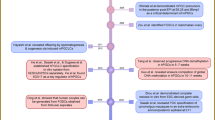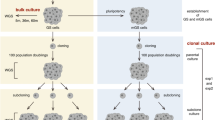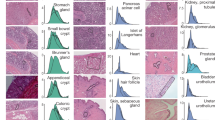Abstract
Replying to: K. Ko et al. Nature 465, 10.1038/nature09089 (2010)
Ko et al.1 challenge our description of human adult germline stem cells (haGSCs)2, indicating that we have instead cultured testis fibroblasts. However, they do not follow the experimental procedures we describe2 and so fail to reproduce our findings.
Similar content being viewed by others
Main
We repeated the procedures used by Ko et al. that produced fibroblasts1 by using parts of our own protocol2 with human testis tissue, but omitting the array of selection procedures described there — such as MACS (magnetic-activated cell separation) and matrix selection of germ stem cells. We confirmed that it is indeed impossible to establish a germ-cell culture in this way, as Ko et al. know from their mouse studies. In the resulting cultures, the plates are overgrown with somatic cells that aggregate to clumps of cells: most of these cells are probably fibroblasts. The populations of human testicular fibroblast cells (hTFCs) described by Ko et al.1 are a completely different cell population and are not comparable to haGSCs.
Fibroblasts are not germ stem cells and are unable to differentiate into cells of all germ layers, as the cells we describe did2. However, the microarrays on which Ko et al. place emphasis were only one of several molecular and functional tests we used2 to detect similarities to human embryonic stem cells (hESCs).
According to the Microarray Facility Tübingen, one of the critical points of the challenge by Ko et al.1 is that they use our data set for comparison with their own expression profiles from different cell types. The use of microarrays that are generated several days or months apart introduces systematic batch effects or non-biological differences, which make it meaningless to compare samples from different batches directly. Batch effects are inevitable when new samples or replicates are added incrementally to an existing array data set, or when a meta-analysis of multiple studies pools microarray data across different laboratories3. Statements about comparisons between the different data set are therefore not constructive.
We are now working on the selection and amplification of our haGSCs so that we have sufficient cell material to share with colleagues. Detailed protocols are available from us and the authors of refs 2, 4–6 for those who wish to investigate haGSCs further.
References
Ko, K. et al. Human adult germline stem cells in question. Nature 465 10.1038/nature09089 (2010)
Conrad, S. et al. Generation of pluripotent stem cells from adult human testis. Nature 456, 344–349 (2008)
Rhodes, D. R. et al. Large-scale meta-analysis of cancer microarray data identifies common transcriptional profiles of neoplastic transformation and progression. Proc. Natl Acad. Sci. USA 101, 9309–9314 (2004)
Golestaneh, N. et al. Pluripotent stem cells derived from adult human testes. Stem Cells Dev. 18, 1115–1126 (2009)
Kossack, N. et al. Isolation and characterization of pluripotent human spermatogonial stem cell-derived cells. Stem Cells 27, 138–149 (2009)
Mizrak, S. C. et al. Embryonic stem cell-like cells derived from adult human testis. Hum. Reprod. 25, 158–167 (2010)
Author information
Authors and Affiliations
Corresponding author
Ethics declarations
Competing interests
The authors declare no competing financial interests.
Rights and permissions
About this article
Cite this article
Conrad, S., Renninger, M., Hennenlotter, J. et al. Conrad et al. reply. Nature 465, E3 (2010). https://doi.org/10.1038/nature09090
Issue Date:
DOI: https://doi.org/10.1038/nature09090
This article is cited by
-
Stem-cell furore erupts
Nature (2010)
Comments
By submitting a comment you agree to abide by our Terms and Community Guidelines. If you find something abusive or that does not comply with our terms or guidelines please flag it as inappropriate.



